 Back to selection
Back to selection
Shutter Angles
Conversations with DPs, directors and below-the-line crew by Matt Mulcahey
“Comedy is Hard to Create, but It’s Easy to Evaluate”: Director David Leitch on Blending Action and Laughs in Deadpool 2
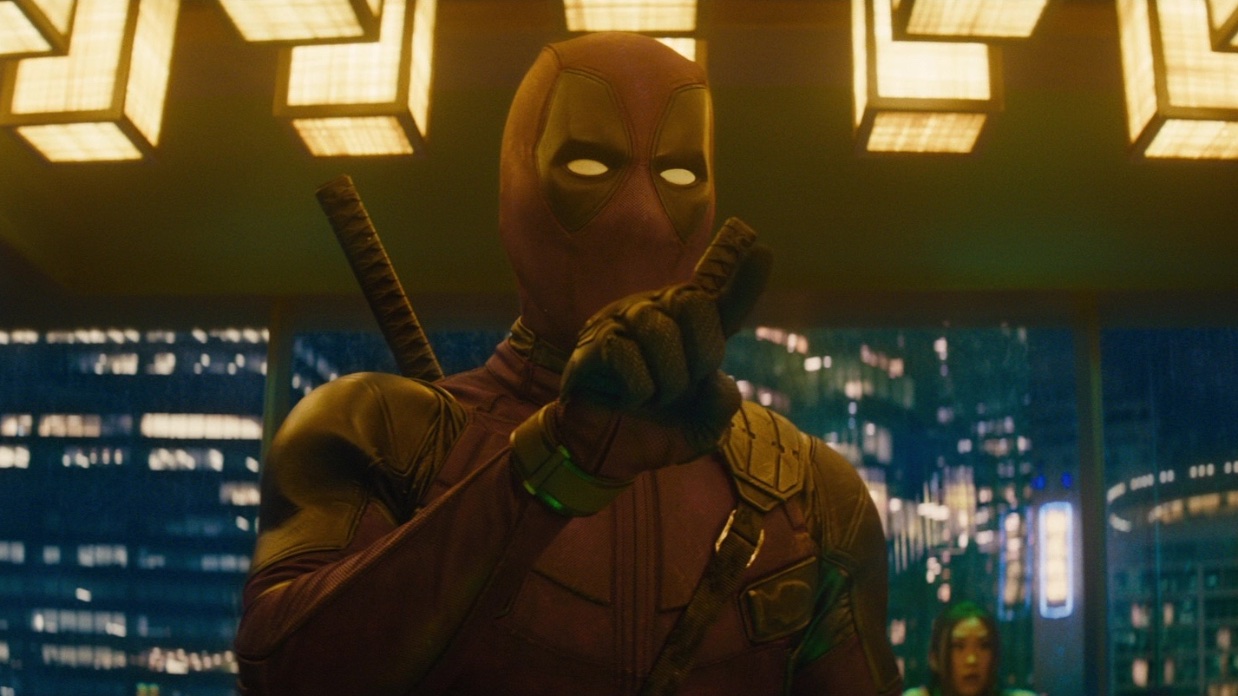 Deadpool 2
Deadpool 2 Long ago, in the dark ages of my childhood, we watched movies on broadcast television and non-premium cable like savages. In this primordial time, bereft of binging and Blu-rays, TV was where movies went to have their aspect ratios cruelly chopped and all the good bits edited out. The only joy came from seeing how censors would creatively shoehorn nonsensical profanity substitutes into everything from Back to the Future to Scarface. “This town is like a great big chicken waiting to be plucked.” Basically the same thing. “You caused 300 bucks damage to my car you son of a butthead.” Actually, that one is better.
Once Upon A Deadpool offers a chance to relive those bygone days — and also to take your kid to see the “Merc with a Mouth” without the condemning stares of judgy parents. Beginning today and running through Christmas Eve, Fox is putting a PG-13 rated re-release of Deadpool 2 back into theaters — with $1 of every ticket sold going to the charity Fudge Cancer. Considering the franchise’s penchant for the meta, I expect slightly better f-bomb replacements than “I don’t bargain, pumpkin hugger.”
With Deadpool 2 returning to the big screen, here’s my interview from the film’s original release with stuntman-turned-director David Leitch — or as the amusing opening credits call him, “One of the guys who killed the dog in John Wick.”
Filmmaker: A couple of your first jobs as a stuntman were on early Trey Parker/Matt Stone movies. What do you remember about your time on Orgazmo (1997) and BASEketball (1998)?
Leitch: Orgazmo was a really small independent movie that those guys wrote, acted in, and directed. I was an up-and-coming stuntman and I got a call to double Trey Parker. There were some fight scenes in that movie and we choreographed those and did some fight stunts. From there those guys did BASEketball for Universal, and I got called to double Trey again.
Filmmaker: I see some TV gigs listed on your IMDB credits before that, but was Orgazmo your first feature?
Leitch: It may have been. It was definitely one of the first. I also did some stuff out of the country when I was starting out. I did a movie called Perfect Target in Mexico with this guy Daniel Bernhardt as the star. He’s actually a really good friend of mine now who does a lot of stunt acting roles for us. In Atomic Blonde he fights Charlize [Theron], and then in the first John Wick he fights Keanu [Reeves]. But back then he was sort of a low-budget action star.
Filmmaker: You’ve worked on comedies as part of the stunts team, but as the director of Deadpool 2 you’re now the arbiter of what’s funny. How do you gauge what’s working comedically?
Leitch: Comedy is hard to create, but it’s easy to evaluate. It’s pretty empirical. People laugh or they don’t laugh. You get an immediate response from the audience. But with a dramatic performance, you don’t have that same sort of visceral response. It’s a little bit more subjective. In terms of creating it, I’m a huge fan of comedy. I’ve actually done some comedy in shorts and independent films that I’ve made as a writer and director so it was great to get to work on something more comedic and not just be defined as an action guy.
Filmmaker: Do you have a favorite joke that you came up with that made its way into the movie?
Leitch: It’s hard to know whose idea any joke was because it was a really collaborative atmosphere and it was sort of “the best idea wins.” That’s how I like to direct, to create an environment where people feel like they can suggest ideas. A lot of it is just sifting through Ryan’s improvs and saying “Wait, that one was great. Let’s do that one again.” But I do remember the “Zip it, Thanos” line was mine. That’s probably my favorite.
Filmmaker: Was there a bit that you loved that didn’t work for audiences as much as you thought it would?
Leitch: Karan Soni has a line, “The Proposition has a wonderful Guy Pearce performance.” (laughs) That’s a good one. That gets me every time, but it doesn’t necessarily get a big laugh from audiences.
Filmmaker: I love the movie’s soundtrack. When you’re at the budget level of a Deadpool 2, can you pretty much get anything you want?
Leitch: I will say this — the studio was really generous. Our line item for music was initially about half of what we ended up [spending]. So we doubled that music budget pretty quickly because audiences were enjoying it during the test screenings and the studio said, “Okay, let’s pay for it. This isn’t a place to cut corners.” Music is such a huge part of the Deadpool experience. “Thunderstruck” was one of the more costly songs. Getting the usage of Yentl from Barbra Streisand was actually remarkably easy. She was a great sport. A lot of the artists were supportive because it was Deadpool.
Filmmaker: The movie loves to punctuate moments with ironic music cues, but there’s an acoustic version of A-ha’s “Take on Me” that’s played with complete sincerity.
Leitch: A lot of the songs were picked from the beginning and were baked into the script. I liked to play them on set before we would shoot scenes, but that one was a find-it-in-post idea. We had a great music editor who was helping put temp music in for the movie and we needed some source music for a scene [between Ryan Reynolds’s Deadpool and Morena Baccarin’s Vanessa] in their apartment and “Take On Me” became this lovely song for that moment. We were actually in the middle of making an acoustic version of “Ashes,” the Celine [Dion] song that was created for the movie’s opening credits, to use for that apartment scene. We temped in A-ha and when we screened the movie people kept saying, “Oh my God, I love that song!” It was just one of those perfect things.
Filmmaker: Before you transitioned into directing, one of the things you were known for was choreographing action set pieces through a company, 87Eleven, that you founded with your John Wick co-director Chad Stahelski. So walk me through the process of how you put together a fight scene.
Leitch: Fight scenes are one of our specialties and we still prepare for them with sort of an old-school version of previs that we call “stunt vis.” Our 87Eleven guys, who have been with me for years, will start choreographing and we’ll shoot the fight rehearsals and then cut the scenes together. Then we’ll repeat that process and refine it over several weeks [during preproduction]. One thing that process allows us to do is train the actors in specific moves that we are going to need them to do. It also allows us to prepare very specific camera angles. There’s generally a very specific camera point of view for our fight scenes. It’s not “Let’s just put a bunch of cameras on it.”
But even with all that prep we’ll sometimes get there on the day and change a lot of it. There’s a scene toward the end of the film where Domino [takes out a room full of orderlies] in this Final Destination-esque fight scene, and we ended up choreographing that on the day. So that scene changed from the stunt vis, which had been planned for a month, but I really wanted to have more fun that day with the idea of Domino’s luck as a power.
Filmmaker: That does seems like an amusing idea to play around with.
Leitch: It was. We had different versions of the idea of “luck.” At first we had Buster Keaton-esque bits planned where guys were swinging and missing Domino because she would [bend down] to tie her shoe. We came up with a bunch of cool fights like that, but then we thought, “What if it was more of a Rube Goldberg type of thing,” where Domino knocks over a can of paint and the paint rolls down a hill and hits a curb and that makes a car flip and then that car creates a ramp that she can run up.
Filmmaker: How does the process of creating a fight scene differ when that fight is between two entirely CGI characters such as Colossus and Juggernaut?
Leitch: At first I was trying to just design the scene and choreograph it in my head and that was difficult. So I went back to the old method and I got two stunt guys in a room and put them in motion capture costumes, choreographed the fight, and then shot [a test version of it]. We put that footage into the computer and we used a program to move the camera around and create different angles. It was basically like doing our stunt vis, but a little bit more high tech version of it. So in the end I just needed two artists duking it out.
Filmmaker: How did you first meet your cinematographer Jonathan Sela? Was it on Midnight Meat Train?
Leitch: Yeah, that was the first time we met. I was second-unit director on that. Ryûhei Kitamura (Versus, Azumi) was the director and he was a really fun guy, a collaborative guy. I choreographed a fight scene inside a train and it was sort of the climactic fight between Vinnie Jones and Bradley Cooper. I brought in my stunt vis and said “Here’s how I would choreograph, shoot, and edit this.” And Ryûhei said “Go meet with Jonathan and show him. I want to shoot it like this.” So I met Jonathan and we broke down all the angles and he was really fascinated by the (stunt vis) process. We got along on that shoot and I thought we did some interesting stuff on that weird movie. When we got the call maybe seven years later to do John Wick, I told (co-director) Chad (Stahelski), “We’ve got to get this guy Jonathan Sela. He’s amazing. I love his compositions. I love his visual storytelling. Above all that, he’s a great guy.” So we reached out to Jonathan and we were lucky that he came out and did John Wick with us because he was a huge part of the look of that movie. We’ve worked together on every film I’ve directed since.
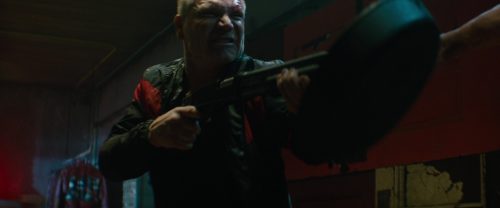
Filmmaker: I want to finish up by asking you about a few specific shots. I’ve read you talk about being a big fan of Jackie Chan and there’s this bit early in Deadpool 2 that reminded me of him, where Deadpool uses a frying pan to redirect a shotgun blast. I loved that little touch. Where does a moment like that come from?
Leitch: A lot of times you choreograph in the gym or on the sound stage and then when you get to the set, the set dressing is all there and there’s a lot more props around and you think, “Oh, we should adjust this.” It’s just us trying to make the fight scenes interesting and to get away from the (monotony) of right-left-right, kick-punch-kick. So we were trying to use our surroundings and have some fun with it and that’s what Jackie Chan does so well.
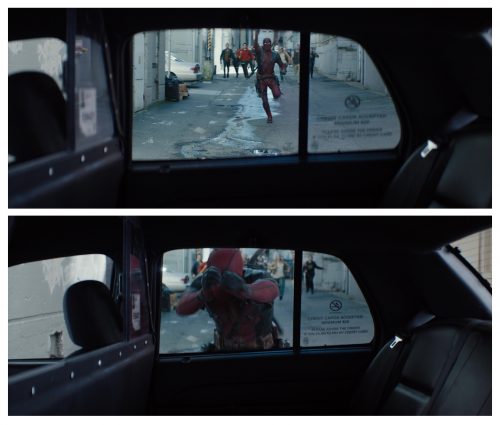
Filmmaker: There’s a stunt early in the movie where Dopinder’s cab is waiting in an alley and Deadpool comes sprinting down the alley and jumps through the cab’s rear passenger side window. How difficult is that stunt to pull off?
Leitch: It’s not that dangerous, but it’s actually really difficult to do. It’s just hard to get your body in that narrow of a place and to do it at full speed. It was a tricky stunt, but we had Jackson Spidell doing it, who’s a great stunt performer, and he makes things look easy. He’s one of the best stunt performers I’ve ever worked with and I’ve done a lot of movies with him. He has this body awareness that’s amazing.
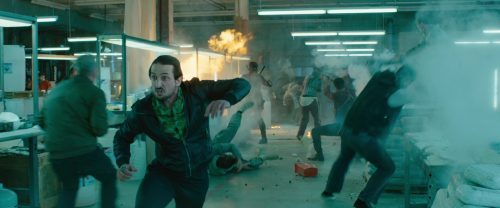
Filmmaker: Another shot I like from early in the film is when Deadpool is chasing a bad guy through a warehouse. Deadpool is pursuing at regular speed in the background while the villain runs in slow motion in the foreground. Is that motion control with multiple passes or is the foreground element shot against greenscreen and composited in?
Leitch: It was motion control. We also did some element passes too. That scene comes at the end of the movie’s opening montage and we wanted to finish it with something fun and sort of slow down time a little bit so that [Reynolds’s] voiceover there could really land. That was a complicated shot, actually. It took us a day to block it, set it up, and shoot it.
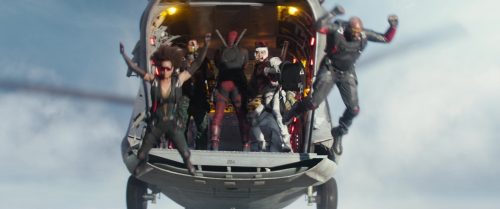
Filmmaker: How about the sky diving scene where The X-Force makes a less-than-successful debut?
Leitch: That was done on greenscreen on a stage. We had the helicopter on a gimbal and it was probably 15 feet off of the floor and then we had mattresses and a box rig underneath for the performers [to fall into]. A lot of times in stunts you jump into boxes because they’re actually safer than mats in a lot of respects. So we set up a box rig and put some mats on top and walked the actors through a couple of rehearsals and they were ready to go. If you look at the framing, they’re dropping maybe six feet out of frame. There was a really good visual effects team on this. I think the best way to make visual effects look great is to have as many practical elements as possible and then enhance it. We did that in as many cases as we could.
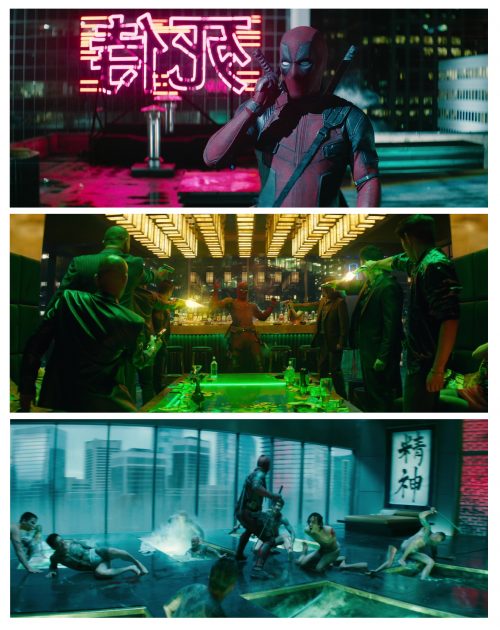
Filmmaker: My favorite sequence in the movie is the opening montage set to Dolly Parton’s “9 to 5,” which follows Deadpool’s exploits around the globe. You and Jonathan Sela get to play with color in that montage similar to the way you did in John Wick and Atomic Blonde.
Leitch: That’s actually one of my favorite scenes too. It was hard for me to cut that down to the length that it is in the movie. There’s a lot more action and all these little details that had to go by the wayside because of the pace of the movie. You really wanted to get into the story and you didn’t need so much of it. But I loved that sequence. When [Deadpool] first crashes through the window into the Triad’s den in Hong Kong, the colors in there are amazing with all this green and gold. It’s a great combination of Jonathan Sela’s lighting, David [Scheunemann’s] production design, and the fight choreography. That fight scene in its full entirety is my favorite fight that I’ve ever choreographed.
Matt Mulcahey works as a DIT in the Midwest. He also writes about film on his blog Deep Fried Movies.
